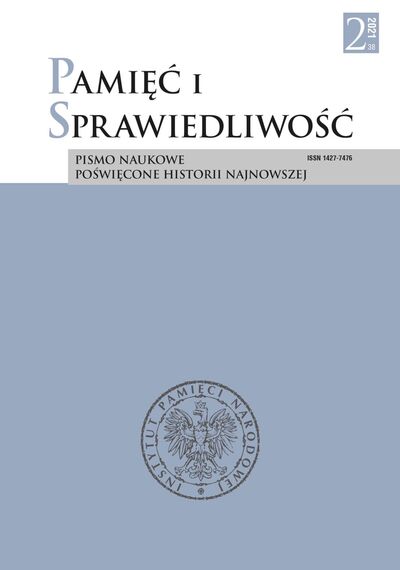Dwa pierwsze lata na Wawelu. Geneza konfliktu o trumnę marszałka Józefa Piłsudskiego (1935–1937)
Pamięć i Sprawiedliwość, Vol. 38 No 2 (2021), pages: 322-346
Publication date: 2021-12-30
 https://doi.org/10.48261/pis213818
https://doi.org/10.48261/pis213818
Résumé
Śmierć Pierwszego Marszałka Polski została wykorzystana przez jego zwolenników w maju 1935 r. i czerwcu–lipcu 1937 r. w sposób polityczny. Uroczystości pogrzebowe były bezprecedensowym, a zarazem symbolicznym wydarzeniem. Wykorzystane środki służyły podkreśleniu wielkości i zasług Józefa Piłsudskiego, jako ponadprzeciętnego obywatela Rzeczypospolitej. Uroczystości pogrzebowe trwały kilka dni, żałoba narodowa sześć tygodni. Utworzono Naczelny Komitet Uczczenia Pamięci Marszałka Józefa Piłsudskiego z zadaniem kompleksowego uhonorowania postaci zmarłego. Całość działań koordynował Wydział Wykonawczy, dla którego najważniejszym zadaniem stało się doprowadzenie do złożenia trumny w krypcie pod Wieżą Srebrnych Dzwonów na Wawelu. Zadanie było niezwykle trudne z uwagi na zakres i stopień prac w Katedrze Wawelskiej, będącej we władaniu Kościoła katolickiego. Odmienność celów obu stron (świeckiej i kościelnej) bardzo szybko dała o sobie znać, doprowadzając do konfliktu, który rozpoczął się praktycznie natychmiast po złożeniu ciała i trwał do lata 1937 r.
Artykuł dotyczy genezy sporu, wątku dotychczas marginalizowanego. Badacze koncentrowali się przede wszystkim na najważniejszym momencie konfliktu, tj. wydarzeniach z czerwca i lipca 1937 r., pomijając przyczyny, które doprowadziły do jego wybuchu. Analiza materiału źródłowego pozwoliła odtworzyć wydarzenia z lat 1935–1937, dzięki czemu możliwe było spojrzenie na ten problem badawczy z innej perspektywy. Efektem są ustalenia dotyczące przyczyn eskalacji sporu o trumnę Piłsudskiego. Powodem była nieodpowiedzialność akolitów, ale też i upór metropolity krakowskiego Adama Stefana Sapiehy, co doprowadziło do jednego z największych kryzysów społecznych dwudziestolecia międzywojennego w Polsce. Rozważania kończą się na 23 czerwca 1937 r., a więc w momencie, w którym konflikt z „gabinetowego” stał się ogólnonarodowym.
Celem było również pokazanie długiego i, jak się okazało, banalnego procesu dochodzenia do wybuchu konfliktu w czerwcu 1937 r. oraz roli poszczególnych jednostek, których postawa i działania doprowadziły do sytuacji, w której żadna ze stron, nie czując się odpowiedzialną za zaistniałą sytuację, nie chciała ustąpić. Kryzys ostatecznie, po miesiącu intensywnych działań z udziałem Prezydenta Rzeczypospolitej oraz dyplomacji polskiej i watykańskiej, udało się zażegnać. Trudno zobrazować jego społeczne konsekwencje, ale miał on niewątpliwie wpływ na postrzeganie osoby arcybiskupa Sapiehy, jeśli zważyć na fakt, że demonstrujący domagali się umieszczenia go w Berezie Kartuskiej.
Références
Codex Iuris Canonici PII X Ponticfiis Maximi iussu digestus Benedicti Papae XV auctoritate promulgatus, 1917, p. II, p. 344, [in:] https://www.pbc.rzeszow.pl/dlibra/publication/19164/edition/17423/content?ref=desc [accessed 30 VI 2021].
Pro memoria abpa A.S. Sapiehy o „koniflkcie wawelskim” [in:] Księga sapieżyńska, vol. II, ed. J. Wolny and R. Zawadzki, Cracow 1986.
Jędrzejewicz W., Kronika życia Józefa Piłsudskiego 1867-1935, vol. II: 1921-1935, London 1977.
Konkurs na sarkofag J. Piłsudskiego na Wawelu [Warsaw, 25 XI 1936].
Piłsudska A., Wspomnienia, ed. A. Adamczyk, Warsaw 2004.
Eden A., Pamiętniki 1923-1938, vol. I: W obliczu dyktatorów, ed. S. Zabiełło, transl. J. Meysztowicz, Warsaw 1970.
Składkowski F.S., Strzępy meldunków, ed. A. Garlicki, Warsaw 1988.
Zamorski K.J., Dzienniki (1930-1938), eds. R. Litwiński i M. Sioma, Warsaw 2011.
Cichoracki P., Legenda i polityka. Kształtowanie się wizerunku marszałka Józefa Piłsudskiego w świadomości zbiorowej społeczeństwa polskiego w latach 1918-1939, Cracow 2005.
Czajowski J., Kardynał Adam Stefan Sapieha, Wrocław 1997.
Gałęzowski M., Przewoźnik Andrzej., Gdy Wódz odchodził w wieczność… Uroczystości żałobne po śmierci Marszałka Józefa Piłsudskiego 12-18 maja 1935 r., Warsaw 2005.
Garlicki A., Józef Piłsudski 1867-1935, Warsaw 1990.
Hein-Kircher H., Kult Piłsudskiego i jego znaczenie dla państwa polskiego 1926-1939, transl. Z. Owczarek, Warsaw 2008.
Kajzer P., Mauzoleum marszałka Józefa Piłsudskiego na Wawelu w latach 1935-1989, Cracow 2018.
Majchrowski J.M., Ulubieniec Cezara Bolesław Wieniawa-Długoszowski. Zarys biograifi, WrocławWarsaw-Cracow 1990.
Sioma M., Sławoj Felicjan Składkowski (1885-1962). Żołnierz i polityk, Lublin 2005.
Warszawski J., Studia nad wyznaniowością Józefa Piłsudskiego, London 1978.
Cichoracki P., Naczelny Komitet Uczczenia Pamięci Marszałka Józefa Piłsudskiego 1935-1939 - mechanizmy działania, „Dzieje Najnowsze” 2002, no. 4.
Mrowiński P.M., „Bo królom był równy…” Sprowadzenie szczątków Juliusza Słowackiego w 1927 roku jako dramat społeczny Victora Turnera, „Vade Nobiscum” 2019, vol. XXI.
Vetulani A., Arcypasterz krakowski na przełomie epok Adam Stefan Sapieha w latach 1912-1939, [in:] Kościół w II Rzeczypospolitej, ed. Z. Zieliński and S. Wilk, Lublin 1981.
Wolny J., Koniflkt wawelski , [in:] Księga sapieżyńska, vol. II: Działalność kościelna i narodowa Adama Stefana Sapiehy, eds. J. Wolny and R. Zawadzki, Cracow 1986.
Mozołowski S., O chorobie poprzedzającej zgon Marszałka Piłsudskiego, „Gazeta Polska”, nr 297, 26 X 1935.
Paryż o wizycie warszawskiej, „Gazeta Polska”, no. 129, 11 V 1935.
Sprawa emblematów dekoracyjnych krypty Marszałka Piłsudskiego. Oświadczenie gen. Wieniawy-Długoszowskiego, „Gazeta Polska”, no. 172, 23 VI 1937.
Stefanowski A. dr, Przebieg choroby Marszałka Józefa Piłsudskiego, „Gazeta Polska”, no. 297, 26 X 1935.
Zdumiewające zarządzenie ks. metropolity Sapiehy. Samowolna decyzja przeniesienia trumny Marszałka Piłsudskiego. Nieprzyjęta prośba o dymisję Rządu, „Gazeta Polska”, no. 173, 24 VI 1937.
https://audiovis.nac.gov.pl/obraz/23525/ec53fc9adabe15dc99e78d028a1fcd86/ [accessed 27 V 2020]
https://www.polskieradio.pl/130/5561/Artykul/1718247,Sarkofag-dla-marszalka-Jozefa-Pilsudskiego-Mamy-obowiazek-to-zrobic [accessed 27 V 20
Licence
(c) Tous droits réservés Pamięć i Sprawiedliwość 2023

Ce travail est disponible sous licence Creative Commons Attribution - Pas d'Utilisation Commerciale - Pas de Modification 4.0 International.
 Język Polski
Język Polski
 English
English
 Deutsch
Deutsch
 Français (France)
Français (France)
 Italiano
Italiano
 Русский
Русский



 PDF (English)
PDF (English)




